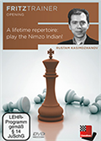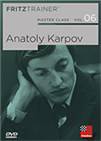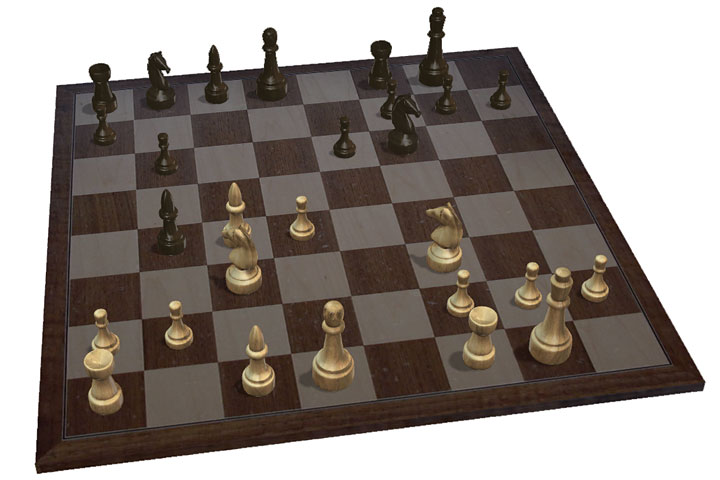The Rubinstein System in the Nimzo-Indian
We have a brand-new application to support this kind of quick learning. Take a look and discover that it's not only useful for your chess, it is great fun!
The line we are dealing with today is this: 1.d4 Nf6 2.c4 e6 3.Nc3 Bb4 4.e3 O-O 5.Bd3 d5 6.Nf3 c5 7.O-O cxd4 8.exd4 dxc4 9.Bxc4 b6.
 This DVD provides everything you need to know to be able to play one of the most classical openings with Black, the Nimzo-Indian, arising after 1.d4 Nf6 2.c4 e6 3.Nc3 Bb4. Nearly every World Championship and top tournament features the Nimzo-Indian.
This DVD provides everything you need to know to be able to play one of the most classical openings with Black, the Nimzo-Indian, arising after 1.d4 Nf6 2.c4 e6 3.Nc3 Bb4. Nearly every World Championship and top tournament features the Nimzo-Indian.The buttons reset the initial position, play forwards / backwards, and get a hint
 On this DVD a team of experts looks closely at the secrets of Karpov's games. In more than 7 hours of video, the authors examine four essential aspects of Karpov's superb play.
On this DVD a team of experts looks closely at the secrets of Karpov's games. In more than 7 hours of video, the authors examine four essential aspects of Karpov's superb play.This is one of the most topical and famous positions in the 4.e3 Rubinstein System of the Nimzo-Indian. White has readily agreed to accept an isolated pawn position in return for speedy development and also some more space. Black, by contrast, believes that he can swiftly complete his development and make White suffer by blockading the square in front of the isolated pawn.
White usually begins by putting his bishop on g5. The knight goes to e5. The rooks do well on the semi-open and open files on e1 and c1 respectively. White should always keep an eye out for the d4-d5 break, when the position would become symmetrical. But the active White forces would create a lot of trouble for Black.
Black, on the other hand, tries to place his bishop on b7, the other knight more often than not goes to d7, sometimes on c6. Black usually has an option to take on c3 with his bishop, but can also retreat to e7. The rook will be well placed on c8. The idea is to blockade the d4 pawn by putting a knight on d5 and not to let White liberate himself with the d4-d5 break.
Players like Karpov love this position from the black side, while aggressive players like Kasparov naturally have an affinity towards the white pieces.
What do you prefer? Go on and try out this extremely rich position against the new interactive Fritz program.
Try to play the Rubinstein line against Fritz
In the window below you have buttons for a number of functions: (From left to right) New game, Take back move, Play move forwards, Play now, Get hint, Very weak opponent, Serious amateur, Club player, Master, Switch colours, analyse with a chess engine.

Hover over the buttons in the actual toolbar below to see their function
Choose an opponent to match your playing strength and try your luck with the Ruy Lopez. This is a good way to prepare for your next beach game, a more serious encounter, your next club tournament, or the international GM event.
Were you able to beat the program? If you were you should try the next-higher level — click the New Game button on the left of the ribbon and the program will jump back to the end of the variation we are learning. Keep doing this to try alternate continuations. You will find that you are learning the ideas behind the Rubinstein line in the Nimzo Indian. It will help you in your games against human opponents.
Here's an example of an amateur playing the Rubinstein line against the "Baby" level of Fritz. Play through the moves and tell us if it doesn't look just like a regular amateur game.

[Event "Baby mode"] [Site "?"] [Date "2018.06.13"] [Round "?"] [White "Freddy"] [Black "Fritz AI "] [Result "*"] [ECO "E54"] [PlyCount "125"] [SourceVersionDate "2018.06.16"] 1. d4 Nf6 2. c4 e6 3. Nc3 Bb4 4. e3 O-O 5. Bd3 d5 6. Nf3 c5 7. O-O cxd4 8. exd4 dxc4 9. Bxc4 b6 10. Ne5 Qc7 11. Bf4 Nc6 12. Ng6 Bd6 13. Bxd6 Qxd6 14. Nxf8 Kxf8 15. d5 exd5 16. Bxd5 Be6 17. Bf3 Qc5 18. Na4 Qe5 19. Bxc6 Rb8 20. Re1 Qf4 21. Qf3 Qxf3 22. Bxf3 Bc8 23. Rad1 Bf5 24. Nc3 Bc2 25. Rd2 Bg6 26. Nb5 Nh5 27. Nxa7 h6 28. Nc6 Rc8 29. Rde2 Nf6 30. Re7 Nh7 31. Rd1 Rxc6 32. Bxc6 Kxe7 33. Rd7+ Ke8 34. Rb7+ Kf8 35. Rxb6 Bd3 36. a4 h5 37. b4 g6 38. a5 g5 39. a6 Bxa6 40. Rxa6 Nf6 41. b5 Ke7 42. b6 Kd6 43. b7 Kc7 44. Ra8 Nd7 45. Bxd7 Kxb7 46. Rf8 Ka7 47. Rxf7 h4 48. Bh3+ Kb6 49. Rg7 Kc6 50. Rxg5 Kc7 51. f4 Kd6 52. f5 Ke7 53. Rg6 Kf7 54. Ra6 Kg7 55. f6+ Kf7 56. Bg4 Kg6 57. Bh5+ Kh7 58. Ra8 Kh6 59. f7 Kxh5 60. Rg8 Kh6 61. f8=Q+ Kh5 62. Qf5+ Kh6 63. Qg6# *
Tell us what you think in the comments or via the "feedback to the editors" link below.
Links

























